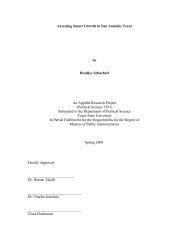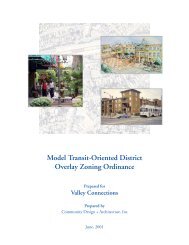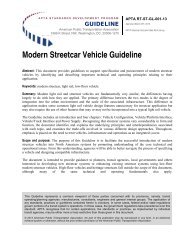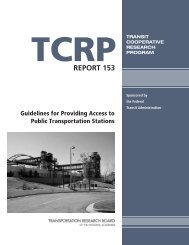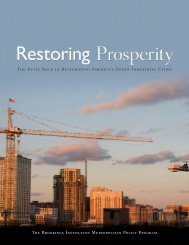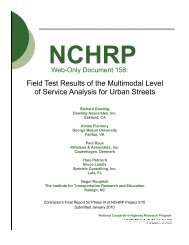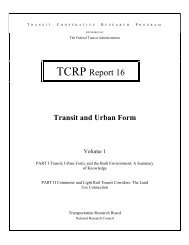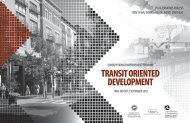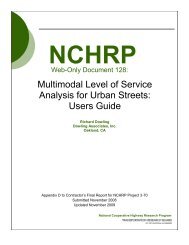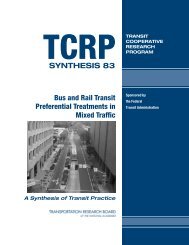Download the full report (PDF, 734 KB) - Reconnecting America
Download the full report (PDF, 734 KB) - Reconnecting America
Download the full report (PDF, 734 KB) - Reconnecting America
- No tags were found...
Create successful ePaper yourself
Turn your PDF publications into a flip-book with our unique Google optimized e-Paper software.
Transit-Oriented Development in <strong>the</strong> Statestrian friendly, and designed to support frequent transit service operating through, collectively or separately, rail, fixedguideway, streetcar, or bus systems on dedicated facilities or available roadway connections.”Fla. Stat. §343.91This law defines transit-oriented development as a mixed-use residential or commercial area designed to maximize accessto public transportation that often incorporates features to encourage transit ridership. A transit-oriented developmentneighborhood typically has a center with a train station, tram stop or bus station surrounded by relatively high-densitydevelopment with progressively lower-density development spreading outward from <strong>the</strong> center, typically within one-halfmile of <strong>the</strong> stop or station.IllinoisIll. Rev. Stat. ch. 35, §11This law creates <strong>the</strong> Business Location Efficiency Incentive Act, which authorizes companies applying to <strong>the</strong> Departmentof Commerce and Economic Opportunity for certain economic development assistance tax credits to seek increasedor extended tax credits if <strong>the</strong> company’s proposed project site is located in an area that capitalizes upon affordableworkforce housing or accessible mass transit. In addition, <strong>the</strong> company may also receive <strong>the</strong> tax credit if it submits to<strong>the</strong> department an approved remediation plan to improve housing or access to mass transit, or <strong>the</strong> company’s project islocated in labor surplus areas.LouisianaLa. Rev. Stat. §51:1783This law defines transit-oriented development as “a mixed-use development, consisting of at least fifty percent multifamilyresidential housing and at least thirty percent commercial or retail facilities, on a single contiguous site, all or partof which is located within one-quarter mile of a multimodal transit center, with at least ten million dollars in capitalexpenditures for new construction or conversion of existing structures.”MaineMe. Rev. Stat. Ann. tit. 30-A, §§5221 et seq.The statute establishes authority for creation of transit-oriented development (TOD) districts under <strong>the</strong> tax incrementfinancing laws to provide an impetus for transit-oriented development. It defines “transit-oriented development” as atype of development that links land use with transit facilities to support and be supported by a transit system, whichcombines housing with complementary public uses such as jobs, retail or service establishments that are located intransit-served nodes or corridors. A TOD area must be no more than one-quarter mile from an existing or plannedtransit facility. Eligible capital costs for a TOD district include, but are not limited to, transit vehicles such as buses, railconveyances and related equipment; bus shelters and o<strong>the</strong>r transit-related structures; benches, signs and o<strong>the</strong>r transitrelatedinfrastructure; bicycle lane construction and o<strong>the</strong>r bicycle-related improvements; and pedestrian improvementssuch as crosswalks, crosswalk signals and warning systems, and crosswalk curb treatments.MarylandMd. Transportation Code Ann. §7-101The law defines transit-oriented development (TOD) as a land parcel within a half-mile of a transit station that isplanned to maximize resident and employee use of transit, walking and bicycling. It allows <strong>the</strong> state and <strong>the</strong> local governmentwith planning responsibility to designate a TOD.National Conference of State Legislatures | 19



